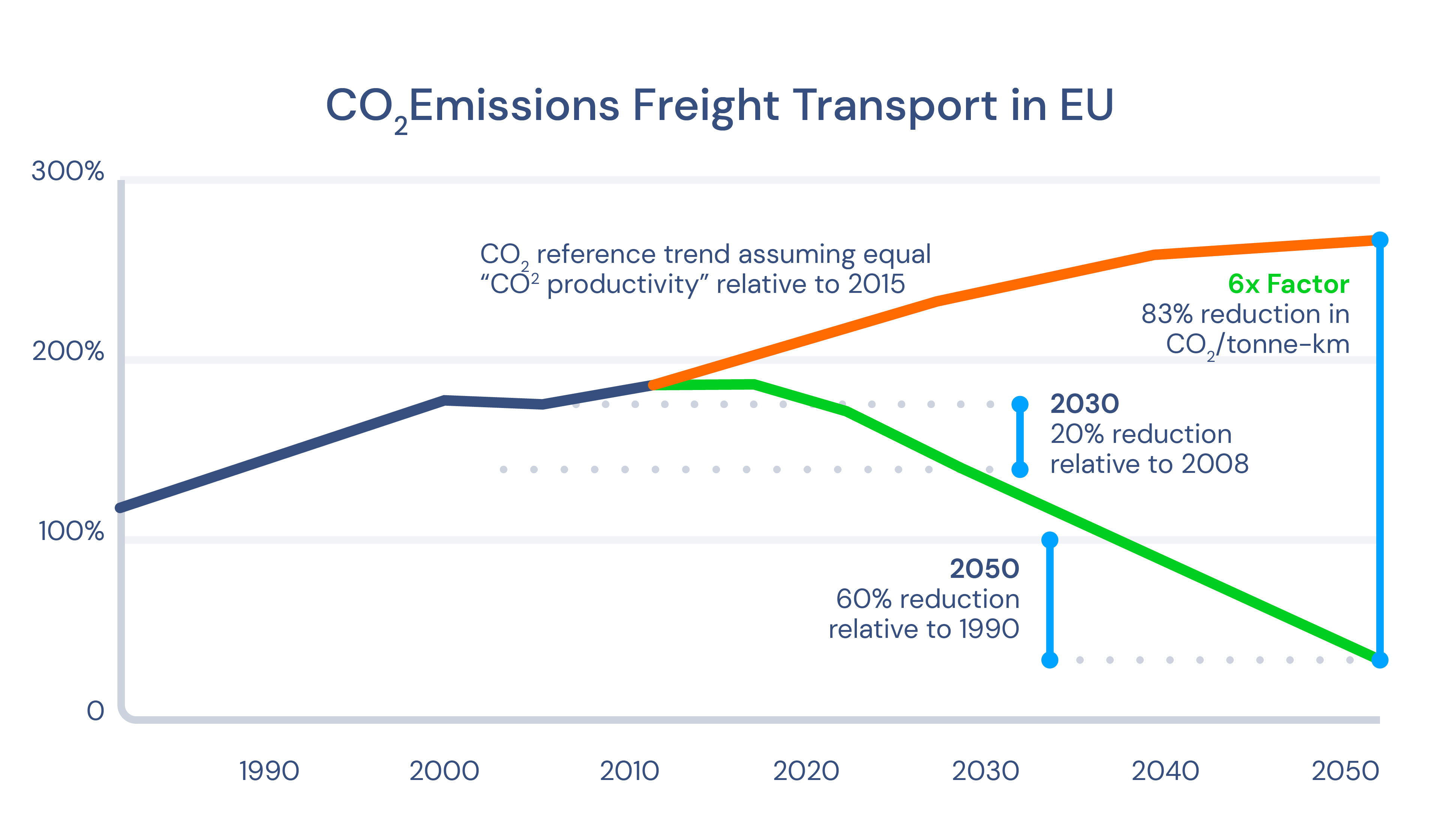of all emissions are generated by transport in the European Union
premature deaths linked to air pollution each year in the EU
of the heavy-duty vehicles are responsible for emissions in the EU
of contribution to total emissions in the European Union
CO2 Emissions From Freight Transport In The EU

The Transport White Paper (2011) “Roadmap to a Single European Transport Area – Towards a competitive and resource efficient transport system” sets targets to decarbonise the mobility sector. By 2050, key goals include:
- No more conventionally-fuelled cars in cities.
- 40% use of sustainable low carbon fuels in aviation; at least 40% cut in shipping emissions.
- A 50% shift of medium distance intercity passenger and freight journeys from road to rail and waterborne transport.
- This will contribute to a 60% cut in transport emissions by 2050
The first-ever EU-wide CO2 emission standards for heavy-duty vehicles, was adopted in 2019. The regulation Regulation (EU) 2019/1242 set targets for reducing the average emissions from new trucks for 2025 and 2030. The regulation entered into force on 14 August 2019. A review is foreseen in 2022.
Target levels: From 2025 on, manufacturers will have to meet the following targets for the fleet-wide average CO2 emissions of their new trucks, compared to EU average in 2019:
- From 2025 onwards: 15% reduction
- From 2030 onwards: 30% reduction (subject to revision in 2022)
The CO2 emission standards regulation covers large trucks (>16t, 4×2 and 6×2 rigid and tractor), which account for 65% to 70% of all CO2 emissions from heavy-duty vehicles.
As part of the 2022 review, the Commission should assess the extension of the scope to other vehicle types such as smaller trucks, buses, coaches and trailers.
Incentive Mechanism for Zero- and Low-emission Vehicles (zlev):
The Regulation includes an incentive mechanism for:
- Zero-emission vehicles (ZEV), trucks with no tailpipe CO2 emissions
- Low-emission vehicles (LEV), trucks with a technically permissible maximum laden mass of more than 16t, with CO2 emissions of less than half of the average CO2 emissions of all vehicles in its group registered in the 2019 reporting period.
To incentivise the uptake of ZLEV and reward early action, a super-credits system applies from 2019 until 2024, and can be used to comply with the target in 2025. From 2025 onwards, the super-credits system is replaced by a benchmark-based crediting system, with a benchmark set at 2%. The 2030 benchmark level will have to be set in the context of the 2022 review.
Penalties
The following penalties will apply for no compliance with the Regulation:
- By 2025: 4 250 €/gCO2 /tkm
- By 2030: 6 800 €/gCO2 /tkm
Directive On The Deployment Of Alternative Fuels Infrastructure
Directive 2014/94/EU requires Member States to develop national policy frameworks (NPFs) for the market development of alternative fuels and their infrastructure; foresees the use of common technical specifications for recharging and refuelling stations; paves the way for setting up appropriate consumer information on alternative fuels, including a clear and sound price comparison methodology. Mandatory targets are set up for charging stations, CNG, LNG. For hdyrogen, the directive aims to ensure a sufficient number of publicly accessible refuelling stations, with common standards, in the Member States who opt for hydrogen infrastructure, to be built by end-2025.
The Commission carried out an assessment of the NPFs and their coherence at Union level, including an evaluation of the level of achievement of the national targets and objectives referred to in Article 3 (1) of the Directive. The relevant Staff Working Document SWD/2017/0365 and the accompanying Member States fiches were adopted by the Commission as part of the Clean Mobility Package (Mobility package II). It has to be noted that while hydrogen is not a mandatory fuel, 15 Members States had included targets for hydrogen refuelling stations.
It is expected that the Alternative Fuels Infrastructure Directive will be revised in 2021
Air Quality
The Ambient Air Quality Directive, (2008/50/EC), establishes standards for a range of pollutants including ozone, particulate matter (PM10), fine particulate matter (PM2.5) and nitrogen dioxide (NO2). Together with Directive 2004/107/EC, the Ambient Air Quality Directive set air quality standards and requirements to ensure that Member States monitor and/or assess air quality in their territory, in a harmonised and comparable manner.
Under these Directives, the Member States should undertake assessments of air pollution levels using measurements, modelling and other empirical techniques – and report air quality data to the European Commission accordingly. Where levels are elevated above limit or target values, Member States should prepare an air quality plan to address the issue and ensure compliance with the limit value. In addition, information on air quality should be disseminated to the public.
The European Commission has completed a fitness check on these two Directives in November 2019. The results are available here.
Local Initiatives Impacting CO2 Emissions And Air Pollution
A growing number of cities are implementing urban vehicles access regulations mesures. An overview is available on a dedicated website.